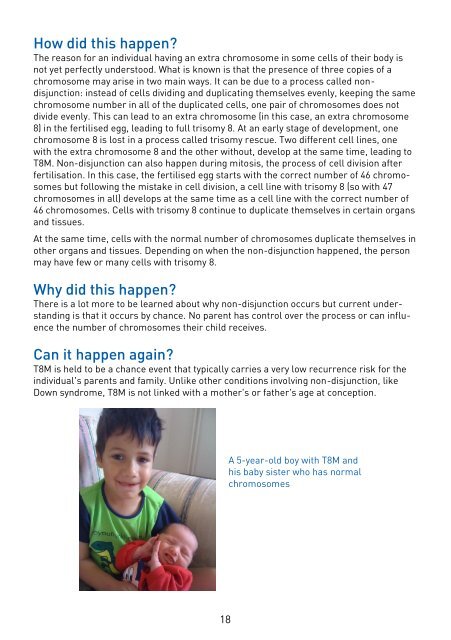Trisomy 8 Mosaicism - Unique - The Rare Chromosome Disorder ...
Trisomy 8 Mosaicism - Unique - The Rare Chromosome Disorder ...
Trisomy 8 Mosaicism - Unique - The Rare Chromosome Disorder ...
You also want an ePaper? Increase the reach of your titles
YUMPU automatically turns print PDFs into web optimized ePapers that Google loves.
How did this happen?<br />
<strong>The</strong> reason for an individual having an extra chromosome in some cells of their body is<br />
not yet perfectly understood. What is known is that the presence of three copies of a<br />
chromosome may arise in two main ways. It can be due to a process called nondisjunction:<br />
instead of cells dividing and duplicating themselves evenly, keeping the same<br />
chromosome number in all of the duplicated cells, one pair of chromosomes does not<br />
divide evenly. This can lead to an extra chromosome (in this case, an extra chromosome<br />
8) in the fertilised egg, leading to full trisomy 8. At an early stage of development, one<br />
chromosome 8 is lost in a process called trisomy rescue. Two different cell lines, one<br />
with the extra chromosome 8 and the other without, develop at the same time, leading to<br />
T8M. Non-disjunction can also happen during mitosis, the process of cell division after<br />
fertilisation. In this case, the fertilised egg starts with the correct number of 46 chromosomes<br />
but following the mistake in cell division, a cell line with trisomy 8 (so with 47<br />
chromosomes in all) develops at the same time as a cell line with the correct number of<br />
46 chromosomes. Cells with trisomy 8 continue to duplicate themselves in certain organs<br />
and tissues.<br />
At the same time, cells with the normal number of chromosomes duplicate themselves in<br />
other organs and tissues. Depending on when the non-disjunction happened, the person<br />
may have few or many cells with trisomy 8.<br />
Why did this happen?<br />
<strong>The</strong>re is a lot more to be learned about why non-disjunction occurs but current understanding<br />
is that it occurs by chance. No parent has control over the process or can influence<br />
the number of chromosomes their child receives.<br />
Can it happen again?<br />
T8M is held to be a chance event that typically carries a very low recurrence risk for the<br />
individual's parents and family. Unlike other conditions involving non-disjunction, like<br />
Down syndrome, T8M is not linked with a mother's or father's age at conception.<br />
A 5-year-old boy with T8M and<br />
his baby sister who has normal<br />
chromosomes<br />
18

















